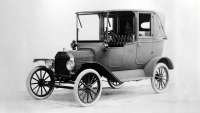If you’ve just come out of a long-term coma and are pondering things like “What are electric cars?” or “When was the electric car invented?” (although we imagine you’d have far more pressing questions, like “Still no flying cars?!”, “How did Carrot Top become President?” and “What’s the deal with all the face masks?”), allow us to explain.
An electric vehicle (EV) is a car with a battery-powered electric motor that runs on electricity, rather than your traditional internal-combustion-engine (ICE) vehicle that runs by burning petrol or diesel fuel.
Who invented the electric car, and what the first electric car was, are questions that are a little harder to answer on account of modern EVs being the end product of decades of scientific breakthroughs and development, with the history books sometimes being a bit murky about who did what, and when (even the question “Who is the Tesla car inventor?” is a difficult one to answer, although we’re pretty certain Elon Musk would be first to claim credit).
Still, here’s a brief primer on early electric cars that will have you talking like an EV know-it-all in no time flat.
Who invented the electric motor?

Crude early versions of the electric motor date all the way back to the 1740s, when Scottish monk and scientist Andrew Gordon and US inventor Benjamin Franklin experimented with basic electrostatic devices.
Over the decades, a laundry list of inventors, scientists and physicists added to further breakthroughs in regards to the development of the electric motor, but the first recorded instance of one being used in a car is when Hungarian priest and physicist Ányos Jedlik used an early electric motor to power a small model electric car in 1828.
Who invented the electric battery?
The wonderfully named Conte Alessandro Giuseppe Antonio Anastasio Volta, or Alessandro Volta for short, is an Italian physicist who invented the electric battery, then called a ‘voltaic pile’, in 1800.
When was the first electric car developed?
.jpg)
The genesis of the first electric car also seems to be the result of innovations generated by a number of people, with key figures being Gaston Planté, a French physicist who invented a rechargeable lead-acid battery; French scientist Camille Alphonse Faure, who improved the battery design in 1881; and Gustave Trouvé, a French inventor who gave a people-carrying electric vehicle a spin on the streets of Paris in April 1881 (a tricycle, but still technically an electric vehicle).
English inventor Thomas Parker built an electric car in 1884 (although the only documentation of the vehicle is a photograph from 1895), which looked a little bit like a horse-less carriage.
Competing with Parker to lay claim to inventing the first ‘real’ electric car is German entrepreneur and inventor Andreas Flocken, who releases the ‘Flocked Elektrowagen’ in 1888 (the first car to run on electricity that looked like an early version of an actual car, rather than a carriage minus the horses).
In the US, the Baker Motor Vehicle Company manufactured electric automobiles in Cleveland, Ohio, from 1899 to 1914.
The first electric cars of the modern era
Henney Kilowatt (1959)
.png)
Electric motor: 5.2 kW
Credited with being the world’s first mass-produced electric car, the Henney Kilowatt was a three-speed automatic, rear-wheel-drive electric vehicle from US car manufacturer Henney Motor Company. The car’s propulsion system was designed and built by the Eureka Williams Company - famous for making vacuum cleaners - in consultation with electrical engineer Victor Wouk, as well as several of his colleagues from Caltech. It was available for two years, and 47 units were sold, mostly to electrical utility companies.
Scottish Aviation Scamp (1965)
.jpg)
Electric motor: 2 x 2.2kW
Developed by the Project Department of Scottish Aviation as a compact two-seater urban commuter vehicle, the idea for the wee Scamp came from the battery-powered tugs tasked with moving baggage trucks at Prestwick Airport in the UK. Coming with a top speed of 56km/h and a range of around 40km, 12 pre-production Scamps were made, but various issues with the car led to its cancellation by 1967.
Electrovair II (1966)
.jpg)
Electric motor: 86 kW
A concept car based on the Chevrolet Corvair, the Electrovair II never made it into production, which is no small surprise when you take into account silver-zinc batteries cost $US160,000 - a fortune now, let alone in 1966. The batteries also didn’t last very long, and offered a driving range between 64 and 129km.
Mars I (1966)
.jpg)
Electric motor: 5.2 kW
The Electric Fuel Propulsion Company (EFP) of Ferndale, Michigan began making electric vehicles in the mid-1960s, including the Mars I, which was based on a Renault Dauphine and had a top speed of 84km/h. The company continued to develop a range of EVs through the ’60s and ’70s, including the Mars II, Mars Van, Electric Eel, Voltair, EPF Hornet, Electrosport, X-144, Santa Fe, Thunderbolt, Transformer I and Silver Volt, although none went into mass production.
Lunar Roving Vehicle (1971)
.jpg)
Electric motors: 4 x 0.19 kW
Affectionately known as the “moon buggy”, this battery-powered EV had the honour of driving astronauts around the surface of the Moon an average of 30km per trip during the Apollo 15, 16 and 17 missions in 1971 and 1972. Built by Boeing and GM subsidiary Delco Electronics, the 210kg LRVs could only handle a payload of 490kg, which typically included two astronauts and all of their assorted equipment and samples. The top speed reached was 18km/h during the Apollo 17 mission. Pathetic, frankly.
Enfield 8000 (1973)
.jpg)
Electric motor: 6 kW
Only 120 units of this electric two-seater were produced by Isle of Wight company Enfield Automotive, which was owned by Greek millionaire Giannis Goulandris. With a top speed of 77km/h and a range of about 64km, the Enfield 8000 was developed by British and Greek engineers. In a headache-inducing move, production of the car was moved from the UK to Greece, but due to tax categorisation issues, the production had to be exported back to - you guessed it - the UK.


.jpg)
.jpg)

.jpg)
.jpg)
.jpg)
.jpg)

.jpg)

.jpg)








